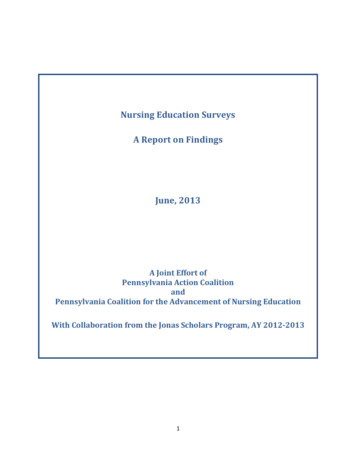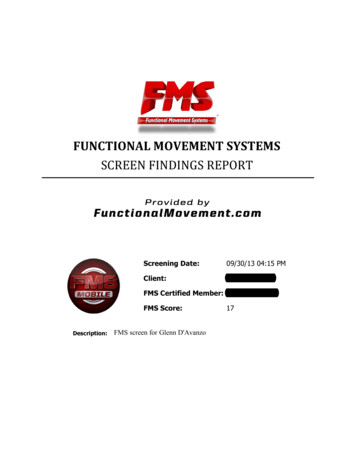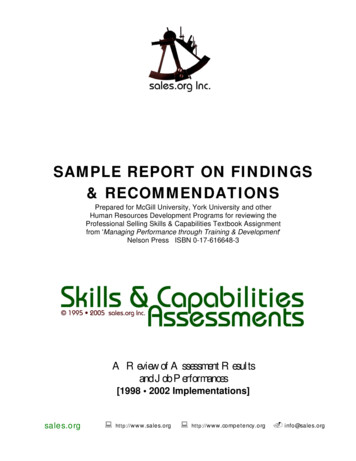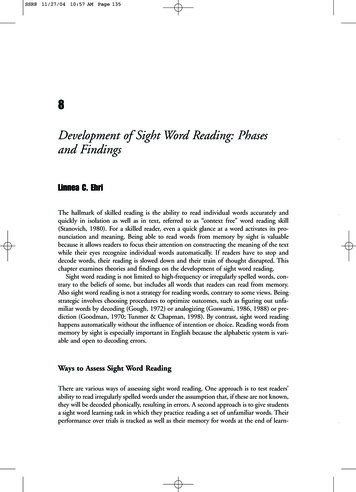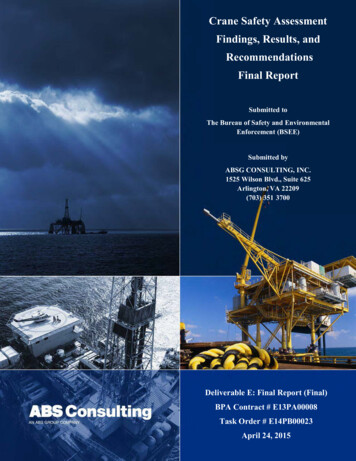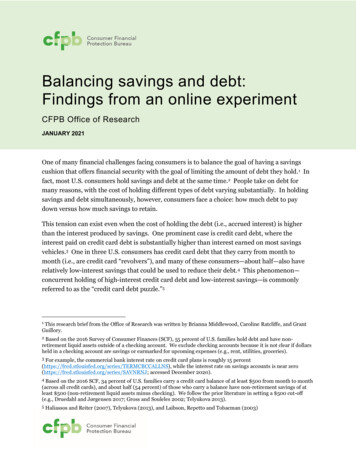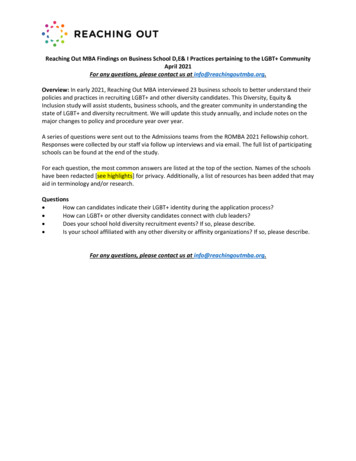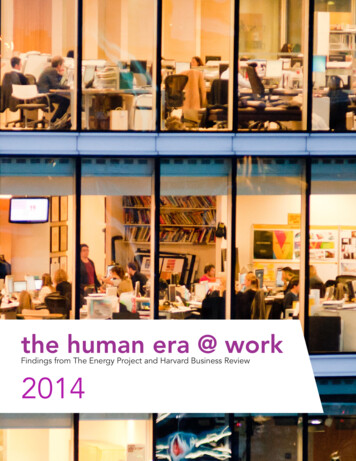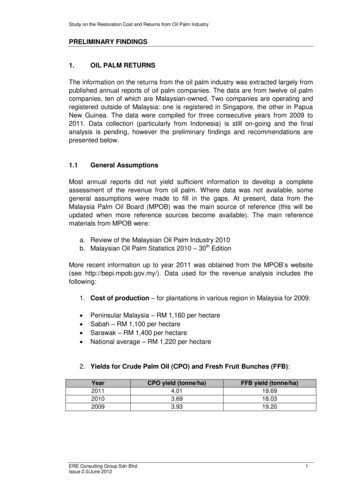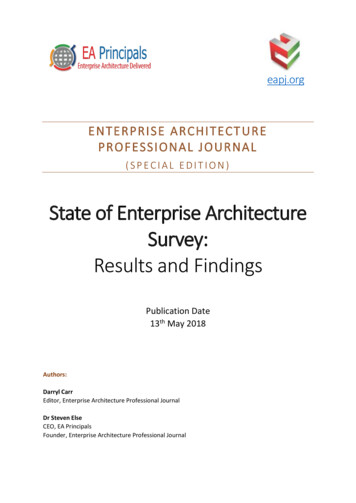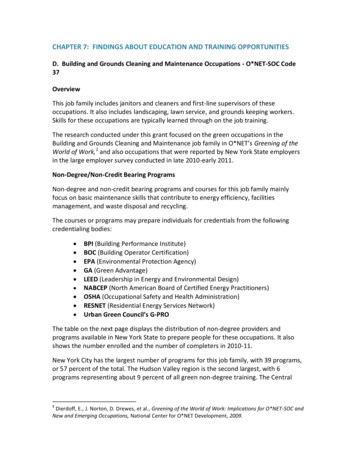
Transcription
CHAPTER 7: FINDINGS ABOUT EDUCATION AND TRAINING OPPORTUNITIESD. Building and Grounds Cleaning and Maintenance Occupations - O*NET-SOC Code37OverviewThis job family includes janitors and cleaners and first-line supervisors of theseoccupations. It also includes landscaping, lawn service, and grounds keeping workers.Skills for these occupations are typically learned through on the job training.The research conducted under this grant focused on the green occupations in theBuilding and Grounds Cleaning and Maintenance job family in O*NET’s Greening of theWorld of Work,1 and also occupations that were reported by New York State employersin the large employer survey conducted in late 2010-early 2011.Non-Degree/Non-Credit Bearing ProgramsNon-degree and non-credit bearing programs and courses for this job family mainlyfocus on basic maintenance skills that contribute to energy efficiency, facilitiesmanagement, and waste disposal and recycling.The courses or programs may prepare individuals for credentials from the followingcredentialing bodies: BPI (Building Performance Institute)BOC (Building Operator Certification)EPA (Environmental Protection Agency)GA (Green Advantage)LEED (Leadership in Energy and Environmental Design)NABCEP (North American Board of Certified Energy Practitioners)OSHA (Occupational Safety and Health Administration)RESNET (Residential Energy Services Network)Urban Green Council’s G-PROThe table on the next page displays the distribution of non-degree providers andprograms available in New York State to prepare people for these occupations. It alsoshows the number enrolled and the number of completers in 2010-11.New York City has the largest number of programs for this job family, with 39 programs,or 57 percent of the total. The Hudson Valley region is the second largest, with 6programs representing about 9 percent of all green non-degree training. The Central1Dierdoff, E., J. Norton, D. Drewes, et al., Greening of the World of Work: Implications for O*NET-SOC andNew and Emerging Occupations, National Center for O*NET Development, 2009.
NY/Southern Tier region has the smallest number of programs with only one programidentified for this region.Building and Grounds Cleaning and Maintenance Occupations – Green Non-DegreePrograms/Non-Credit Bearing CoursesNumber ofProvidersNumber ofProgramsStudentsEnrolled*StudentCompleters*New York City213939332901Hudson Valley36117117Western NY/Finger Lakes44415180Capital District/NorthCountry/Mohawk Valley33150126Long IslandCentral NY/Southern otal* Enrollment and completion data were not reported by all training/education providers.**Online designation is for web based programs and is not one of the LMI Regions.**Blended format programs are included within the 6 LMI Regions.New York City has approximately 85 percent of reported enrollments and completions inthe State, with 3,933 and 2,901 respectively. The “1,000 Green Supers” Program offeredby the Thomas Shortman Training Fund in New York City (see box on next page),accounts for 25% of all reported program enrollment in New York City.Some non-degree programs in New York State include: 1,000 Green Supers ProgramBPI Multi-Family Building Analyst CertificationBuilding Operator CertificationGreenWorks Building Maintenance TrainingHeating Ventilation & Air Conditioning (HVAC) ExcellenceGreen Handyman and Weatherization SpecialistPlumbing and Electricity Basics for Green JobsBasic Property ManagementFacilities 101 Anatomy of a BuildingWater Treatment Grade B & C
The Thomas Shortman Training Fund’s 1,000 Green Supers Program*The Thomas Shortman Training Fund is a joint fund of the Service Employees International Union (SEIU)Local 32BJ and the Realty Advisory Board on Labor Relations. Since 2005, the Fund has been greening NewYork City’s buildings by training building service professionals who are members of 32BJ. They work inresidential apartment buildings, commercial office buildings, theaters and stadiums in New York City.In January 2010, the U.S. Department of Labor awarded a 2.8 million Energy Training Partnership grantto the Shortman Fund to train building superintendents in achieving energy efficiency through betteroperations and maintenance. The 40-hour course covers:1. Building Science & Building Envelope — includes the fundamentals of building science and examines a'whole-building' approach to operations and maintenance. Topics include air movement, heat transfer,and relative humidity. It also covers the core area of the building’s envelope and explores ways to keepconditioned air from escaping to the outside environment. Topics include air barriers, vapor barriers,thermal barriers, air sealing, insulation, pressure boundaries, and compartmentalization.2. Lighting — includes all aspects of lighting. Topics include lighting types, quality, efficiency and controls.The unit also discusses appliance efficiency ratings.3. Heating, Ventilation & Air Conditioning (HVAC) — includes the essentials of running a building’sheating, ventilation, and air conditioning system. Topics include combustion science, combustionefficiency, boilers, controls and distribution as well as efficiency strategies for each of these areas.4. Field Exercise (HVAC): Mechanical Room and Roof — Onsite visit to a building’s machine room androof where instructors will teach supers how to perform steady state efficiency tests, maintain rooftopventilation equipment, and apply efficiency strategies and best practices.5. Sustainability/Indoor Environmental Quality — describes the phenomenon of global warming and howenergy use and waste generated from buildings contribute to global warming. Students learn that themanner in which they perform their jobs has a direct impact on the environment. Also covers the indooratmosphere of a building, strategies to avoid and limit indoor pollutants, an introduction to greencleaning and the concept of green purchasing.6. Water Conservation — includes the essentials of water use and water conservation strategies. Topicsinclude understanding water use, low flow appliances, leak detection, and leak repair.7. Field Exercise: Hallway, Lobby, Apartment — onsite exercise where supers learn how to inspect anapartment, evaluate hallways and common areas, and inspect the building’s envelope.8. Utilities & Energy Benchmarking — includes measuring and managing energy use by understandingand working with utility bills (fuel, gas, electricity, and water). Topics include reading and understandingbills, energy benchmarking, recognizing unusual energy use (trends), and identifying opportunities forsavings.9. Green Building Work Plan — students develop a basic action plan for improving their buildings basedon concepts and strategies taught in earlier units. In addition, the class also discusses strategies andtechniques to communicate effectively with building owners, tenants, and staff on their action plan,including payback and incentives for improvements.10. Review & Practice Exam — a review and a practice test are given to help prepare for the BPI exam.*Information taken from the www.1000supers.com.
Degree and Credit-Bearing Certificate ProgramsAs explained more fully in the Research Methods section of this report (Chapter 1), theresearch partners looked at awards (certificates and degrees) conferred by colleges,universities, and technical and vocational institutions in fields associated with greenemployment. This data was derived from the U.S. Department of Education’s IntegratedPostsecondary Education Data System (IPEDS). Instructional programs were linked tooccupations using the U.S. Departments of Education and Labor’s “CIP–SOC” crosswalk.Because skills for building and grounds cleaning and maintenance are learned primarilyon the job or through non-credit training or coursework, relatively few degree andcredit based programs were identified for this job family.In 2010, 91 people received degrees or certificates that prepared them for work withinthe Building and Grounds Cleaning and Maintenance job family.As shown in the bar chart below, only four of the six NYS LMI Regions have awards inthis job family. These regions include the Western NY/Finger Lakes, CapitalDistrict/Mohawk Valley/North Country, Central NY/Southern Tier and Long Islandregions.
Long Island and the Western NY/Finger Lakes Regions conferred the highest number oftotal awards, with 28 each. The Long Island Region has the highest proportion, with 39percent of total Associate’s Degree awards. The Capital District/Mohawk Valley/NorthCountry region is the only region with Bachelor’s Degree awards for this Job Family.In addition to the degree and credit-bearing certificates in fields associated with greenemployment identified through IPEDS, the researchers found specialized green-relateddegree and credit bearing programs in building and grounds cleaning and maintenanceoccupations.Illustrative specialized green degree and certificate degree programs include: SUNY Ulster and Sullivan County Community College: Green BuildingMaintenance and Management AASMohawk Valley Community College: School Facilities Management CertificateProgramNew York City College of Technology: Continuing Education Courses in BuildingOperationsProgram FocusThe table on the next page displays particular program focus areas. As shown, a largenumber of programs are focused on energy efficiency training.
Degree/CreditProgramsNonDegree/NonCredit ProgramsElectrical / Power / Lightingn/a1Energy Efficiencyn/a2151n/a13n/a1122Multifocus or Other Renewable /Alternative Energyn/a1Solar PVn/a2Solar Thermaln/a114Building and Grounds Cleaning andMaintenance OccupationsEnergy Mgmt / Environmental Mgmt /Sustainability Mgmt / Facilities MgmtGreen Construction / Sustainable Building,Materials and Design:Green Construction, Architecture,Design, Sustainable/Green Building(non-LEED)LEED ProgramOther / MiscellaneousRenewable / Alternative Energy:Waste Management / EnvironmentalRemediation*Programs may be counted toward multiple job families.ConclusionSkills for Building and Grounds Cleaning and Maintenance occupations are learnedpredominantly through on the job training and non-credit training. This is reflected inthe relatively low occurrence of green degree and credit-bearing educational andtraining programs.Building and Grounds Cleaning and Maintenance occupations account for a high level ofgreen employment in New York City, and this is where most of the non-degree/noncredit bearing programs are located, including the 1000 Green Supers program.
The Thomas Shortman Training Fund is a joint fund of the Service Employees International Union (SEIU) Local 32BJ and the Realty Advisory Board on Labor Relations. Since 2005, the Fund has been greening New York ity’s buildings by training building service professiona
